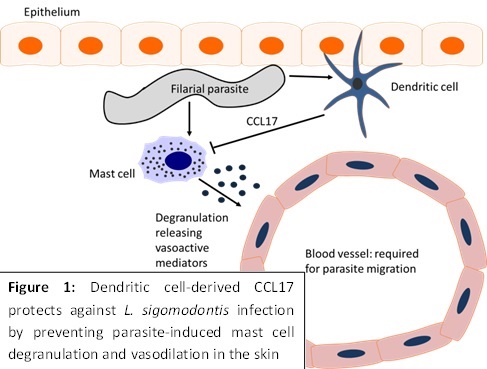Written by William Branchett
Edited by John Mackey
IRD recently hosted Dr Coralie Martin from the Muséum National d’Histoire Naturelle in Paris, who led a seminar and Journal Club on her research of the dynamics of filarial parasite infection. Filariae are nematodes that can cause debilitating and disfiguring diseases such as river blindness, which affects around 37 million people in Africa. Dr Martin utilises the rodent filarial parasite Litomosoides (L.) sigmodontis in mouse models to identify novel strategies for intervention in filarial infection.
In her seminar, Dr Martin focused on the life cycle of L. sigmodontis, which begins by intradermal delivery of larvae via an insect bite. Larvae are known to subsequently reside in the pleural cavity, but the route from skin to lungs had not previously been explored. Dr Martin has utilised both genetically and surgically modified mice to demonstrate an absolute requirement for the lymphatic system in passage of L. sigmodontis larvae to the pleural cavity, and used confocal microscopy to visualise larvae in the lung parenchyma. Furthermore, migration of larvae through the lymphatics was shown to depend on the directional flow of lymph through the system.
 The subsequent journal club focussed on a paper from Dr Martin’s lab describing the role of skin mast cells in the establishment of L. sigmodontis infection. The authors showed that filarial infection triggered chemokine CCL17 expression by dendritic cells, which was required for efficient parasite clearance. The authors went on to attribute the protective effect of CCL17 to a reduction in the numbers of degranulating mast cells, which, if unrestrained, increased vascular permeability, and facilitated filarial movement throughout the host. There was particular interest in the finding that filarial activation of mast cells was dependent on TLR-2-mediated sensing of endosymbiotic bacteria Wolbachia within the L. sigmodontis larvae, adding yet another layer to this story. Together the data suggest a fascinating host-parasite-endosymbiont interaction, where the parasite attempts to subvert local mast cell activation to enable its own migration, but is countered by CCL17 from host dendritic cells (Fig. 1).
The subsequent journal club focussed on a paper from Dr Martin’s lab describing the role of skin mast cells in the establishment of L. sigmodontis infection. The authors showed that filarial infection triggered chemokine CCL17 expression by dendritic cells, which was required for efficient parasite clearance. The authors went on to attribute the protective effect of CCL17 to a reduction in the numbers of degranulating mast cells, which, if unrestrained, increased vascular permeability, and facilitated filarial movement throughout the host. There was particular interest in the finding that filarial activation of mast cells was dependent on TLR-2-mediated sensing of endosymbiotic bacteria Wolbachia within the L. sigmodontis larvae, adding yet another layer to this story. Together the data suggest a fascinating host-parasite-endosymbiont interaction, where the parasite attempts to subvert local mast cell activation to enable its own migration, but is countered by CCL17 from host dendritic cells (Fig. 1).
Dr Martin is currently working with Dr Leo Carlin’s team in IRD to further explore the traffic of L. sigmodontis to the pleural cavity, and we look forward to hearing more from her lab in the future.
For more information on Dr Coralie Martin: http://mcam.mnhn.fr/APE/Fiche_Martin.htm
To read the CCL17 paper: http://www.jimmunol.org/content/early/2011/03/11/jimmunol.1000612